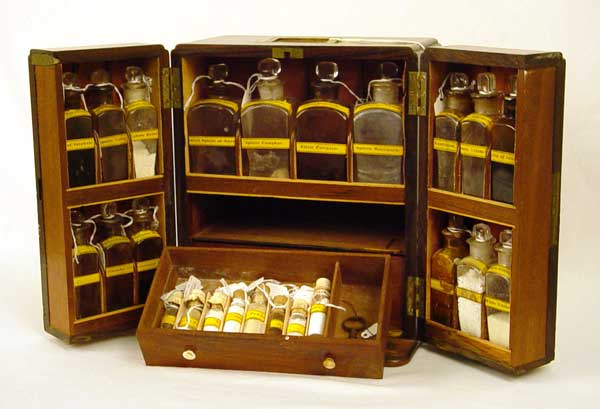After completing this module, students will understand: For each object answer the following questions: Medicine Chest database entry Pill Cutter database entry Strychnine Sulphate database entry DLT Belladonna database entry For each object answer the following questions: C.T. Campbell, Facts and Fallacies about Homeopathy.(PDF 874KB) Advertisement, Globe and Mail, Toronto, 11 June 1898 column 1.(676 KB) Advertisement, Globe and Mail, Toronto, 2, July, 1898 column 6-7 (676 KB). Primary Sources Boys, William Fuller Alves. A practical treatise on the office and duties of coroners in Ontario, and the other provinces, and the territories of Canada, and in the colony of Newfoundland: with schedules of fees, and an appendix of forms. Toronto: Carswell, 1893. Grauvogl, Eduard von. Text Book of Homoeopathy. Chicago: C. S. Halsey; New York: Boericke and Tafel, 1870. Lilienthal, Samuel. Homoeopathic Therapeutics. New York: Boercke and Tafel, 1878. Lutze, Arthur. Manual of Homoeopathic Theory and Practice, Designed for the Use of Physicians and Families. Trans. Charles J. Hempel. New York: Boericke and Tafel, 1872. Schaefer, C.W. Two Medical Systems Contrasted: Homeopathy and Alloepathy. Guelph: Mercury Cheap Book, 1863. Secondary Sources Boussel, Patrice. History of Pharmacy and Pharmaceutical Industry. Paris: Asklepios Press, 1983. Burger, Alfred. Drugs and People: Medications, their History and Origins, and the Way They Act. Charlottesville: University Press of Virginia, 1986. Flannery, Michael A. Civil War Pharmacy: a History of Drugs, Drug Supply and Provision, and Therapeutics for the Union and Confederacy. New York: Pharmaceutical Products Press, 2004. Greffenhagen, George B., and Ernst W. Stieb. Pharmacy Museums and Historical Collections in the United States and Canada. Madison: American Institute of the History of Pharmacy, 1988. Kaufman, Martin. Homeopathy in America: The Rise and Fall of a Medical Heresy. Baltimore: Johns Hopkins Press, 1971. Kirschmann, Anne Taylor. A Vital Force: Women in American Homeopathy. New Brunswick, N.J.: Rutgers University Press, 2004. Richardson, Lillian C. The Pill Rollers: a Book on Apothecary Antiques and Drug Store Collectibles. Fort Washington: Old Fort Press, 1979. Robinson, James W. Prescription for Success: the Rexall Showcase International Story and What it Means to You. Rocklin: Prima Pub., 1999. Salmon, Warren J, ed. Alternative Medicines, Popular and Policy Perpectives. New York: Tavistock Publications, 1984. Stockwell, Christine. Nature's Pharmacy: a History of Plants and Healing. London: Century Hutchinson, 1988. Sumner, Judith. The Natural History of Medicinal Plants. Portland: Timber Press, 2000. Whorton, James. Nature Cures: The History of Alternative Medicine in America. New York: Oxford University Press, 2002.Learning Objectives

Step 1: Objects and Their Properties
Alternative Images
Alternative Images
Alternative Images
Alternative Images
Step 2: The Meaning of an Artifact
Selected References for Further Research
You are using a browser that is not standards-compliant. The information on this Web site will be accessible to you, but for a list of Web browsers that comply with the World Wide Web Consortium standards, please visit our Web standards page.

